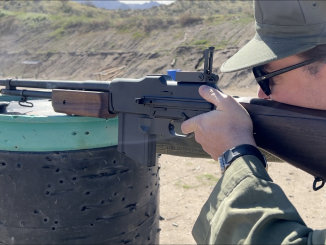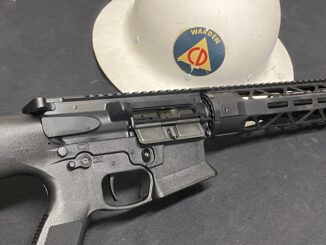The Spiller & Burr was a Confederate copy of the 1854 Whitney revolver, made in .36 caliber under contract to the CSA. As with so many Confederate arms projects, many thousands were promised and only a small fraction actually delivered. The Whitney in particular suffered from a lack of suitable materials, with cylinders having to be made from twisted iron instead of proper steel.
Related Articles

Competition
‘Murican 2-Gun: M1918A3 BAR and M1911A1
Today I’m taking a brand new Ohio Ordnance M1918A3 semiauto BAR to the 2-gun match, along with a Tisas M1911A1 clone. The BAR is the WW2 configuration, but I followed the footsteps of many a […]

Uncategorized
An Economy Model WWSD: The Civil Defense Rifle
The initial rollout of the WWSD2020 rifles has been slow, as a shortage in a couple key components (primarily carbon fiber hand guards) has been a bottleneck in completing rifles. However KE Arms and Brownells, […]

Book review
Book Review: The Whitney Wolverine
The Whitney Wolverine (aka Whitney, Lightning, or Hillson Imperial) was a very space-age looking .22 automatic pistol designed by Robert Hillberg in the 1950s. It made novel use of materials (aluminum castings) and many clever […]

Note the extension of the frame forward compared to the Whitney. This was seen on some other Confederate revolvers, as well. The idea was to reinforce the barrel around the forcing cone, to better resist firing pressure. The reason was that due to raw material shortages, a lot of these revolvers had wrought-iron barrels instead of steel.
The term “twisted iron” needs some explanation. This isn’t the same thing as a “Damascus” twist barrel, made of skelps of steel and iron welded together in a spiral pattern. An iron bar was heated and then literally twisted along its length like taffy or licorice, until it was basically a tight “spiral” structure. This was supposed to “close” the pores in the iron, making it a more homogeneous mass, and thus improving its tensile strength.
According to W.W. Greener, in The Modern Shotgun (1891), what it actually does is set up stresses that embrittle the iron. Shotgun barrels made this way (intended to look like Damascus barrels from outside) tended to burst in short order due to being insufficiently strong to resist firing pressure. I would expect a revolver cylinder made on this principle to fail pretty quickly, as well. I wouldn’t recommend firing a revolver with such a cylinder for that reason.
As for Spiller leaving Baltimore, MD, due to his “Southern sympathies”, more likely he was on Allan Pinkerton or somebody’s “watch” list. Maryland in general, and Baltimore in particular, was a hotbed of “Southern sympathy” and pro-slavery sentiment throughout the war.
In fact, about the only thing which kept Maryland in the Union was the fact that Baltimore and the rest of the state were heavily garrisoned by the Union Army to protect Washington. From its neighbors as much as from the Army of Northern Virginia and Robert E. Lee.
This is one of those not-so-fun facts about the American Civil War that most historians don’t talk much about.
cheers
eon
“The reason was that due to raw material shortages, a lot of these revolvers had wrought-iron barrels instead of steel.”
From post considering weapons of 1860s, it looks that GRAY side (American Civil War) used anything that they could find or craft (and hopefully will not explode)
“This was supposed to “close” the pores in the iron, making it a more homogeneous mass, and thus improving its tensile strength.”
My intuition say it would LOWER uts (ultimate tensile strength) by accumulating stress in said iron.
You and W.W. Greener are on exactly the same wavelength. He noted that “twist iron” barrels on shotguns were made like homogeneous steel barrels, i.e bored from solid rather than hammer-welded to shape over a mandrel.
He also stated that they seldom survived the proof house. Most of those sold outside of Britain came from Belgium, and had spurious markings that looked enough like proof markings from Liege’, etc., to fool the uninitiated. In fact, they had never been fired with a proof charge at all.
Since they often blew out with a relatively light load, odds are they would have been turned into a fragmentation bomb by a proof-house charge.
The stresses induced bu twisting up an iron bar and then boring it out as a shotgun tube are bad enough. But twisting it up and then boring six chambers in it for a revolver cylinder?
That’s a fragmentation grenade waiting to go off in the shooter’s hand.
It’s probably just as well that the revolvers weren’t delivered. Although their wide distribution in the Confederate cavalry might have been a coup for the Union.
cheers
eon
Oh, the humanity… closing porosity in the metals my firm uses is done by hot isostatic pressing. Of course, this would not have been available in 1861. The Confederates may as well have asked a wizard to give them Swedish steel, for backyard furnaces are a failure (something the Chinese Communist Party would learn the hard way)…
First, I’m glad you posted this. I was wondering if there had been a ‘translation error’ and what was really meant by “twisted” iron was “wrought” iron. So, thanks for disambiguation.
Second, don’t overestimate the depth of Southern sympathy in Maryland. Remember, when Lee did his invasion of Maryland his men started with singing “Maryland, my Maryland”, expecting a mass uprising to follow them… and ended the campaign with a parody decrying the fact that nobody actually did uprise or follow. Secession turned out to be a lot more popular in the Speech-Giving Class than it was in the rest of the population.
In fact there were Maryland units on both sides during the war.
Is there REALLY a problem with a brass receiver, when the cylinder and barrel are made of steel?
Depends on the powder charge. Too much pressure and the brass will stretch and deform sooner than iron or steel.
“Depends on the powder charge.”
This apply to all fire-arms. Also using too big bullet is very very bad idea.
Question: what will happen if you excess powder charge?
My understanding is that modern revolvers and other fire-arms are designed that in case of over charge let user alive, see 3rd and subsequent photo from top here:
http://www.littlegun.info/curios%20et%20antiquites/a%20colt%20explose%20gb.htm
Apparently all energy was directed upward, probably not killing user.
Generally, revolver blowups tend to go “straight up” and out to each side.
The usual detonation event consists of the firing chamber disintegrating, the topstrap (if any) being blown straight up, and the chambers at 10 o’clock and 2 o’clock being blown open as the rounds in them detonate with somewhat less force (due to incomplete poweder ignition), splitting the chambers open and sending fragments left and right.
The fragmentation generally covers a roughly 170 degree arc from 9 o’clock to 3 o’clock, making a “fan” about 60 degrees of arc in the horizontal plane on each side.
Assuming the revolver is being fired at full arm extension in the classic style, the shooter is in significantly less danger of injury than onlookers to each side. And yes, this is why indoor firing ranges generally have plywood partitions between firing points. They do a very good job of “catching” the bits before they can injure the person at the next stand.
I’ve seen a few revolver blowups in my time. The classic was someone putting a .44 Remington Magnum round in a .45 Colt by inattention. It will chamber; it will fire; it absolutely will make the revolver go KABOOM. (Especially in a black-powder frame Colt, which this was.)
Note that some older (pre-WW2) .38 Special revolvers have chambers without the internal “shoulder” common on postwar .38s. Meaning, a .357 Magnum will drop right in. KABOOM, again.
In Europe, wartime “expediency” led to tricks like firing 9 x 19mm in S&W “Victory” model .38 S&W (0.380in) revolvers. In fact, the 9mm round drops right in the .38 S&W chamber and even has roughly correct headspace. Still, firing a round with a max SAAMI pressure of 35,000 CUP in a revolver designed for rounds topping out at 14,500 CUP isn’t something you’d want to do if you could avoid it.
Yes, I know that postwar the Israelis had Victory Model revolvers in 9mm. They did it by building new cylinders chambered for 9 x 19mm in M1917-style half-moon clips, and giving the new cylinders and the existing frames and barrels the same heat treatment used on .357 Magnum revolvers by Colt and S&W. And they didn’t make that many, anyway, AFAIK.
BTW, a self-loader blowup proceeds differently. Generally, the slide comes back and jams at full recoil, the chamber splits, there’s a case-head separation, and the force is vented almost straight up, except for what blows down into the magazine. I’ve seen blowups in which the magazine body was still in the well, but the floorplate, spring, follower and rounds remaining were on- and in- the ground at the shooter’s feet.
Moral; Always be careful what goes in the chamber. Especially with handloads.
And make sure what it says on the casehead matches what’s stamped on the barrel. And even then, use caution.
cheers
eon
“Mike-mike-mike! Look at each powder charge. Mike several bullets when you open a new box! Many fine .357 and .44 Mags have gone to that great smelter in the sky because someone got careless.”
Signed, Lefty
“Note that some older (pre-WW2) .38 Special revolvers have chambers without the internal “shoulder” common on postwar .38s. Meaning, a .357 Magnum will drop right in. KABOOM, again.”
Possibility of chamber/cartridge mismatch is reason for 7.5×54 French dimensions: firstly it was 7.5×57 cartridge but it was possible to chamber and fire 7.92×57 in it, which is very bad idea considering bullet diameters of both.
Another fine, informative and educational presentation. WHERE in the firearm World do you find these crazy guns? Keep them coming.